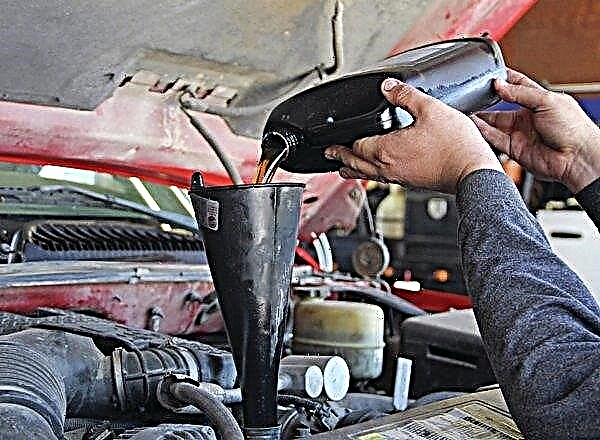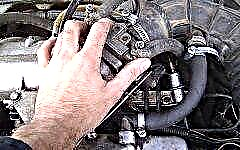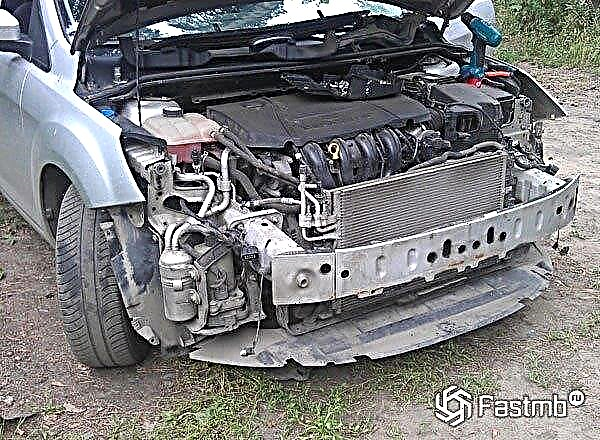It's hard to imagine a modern car without air conditioning or climate control. But not everyone knows how it works, consider the principle of the car air conditioner, breakdowns and the cost of repairs.

The content of the article:
- Prehistory of appearance
- The constituents
- Principle of operation
- Service
- Exploitation
- Repair cost
Comparing cars 10-15 years ago and now, you can see that even in the basic configuration, some manufacturers install air conditioners or climate control systems.
Sometimes when buying a car, the driver does not understand how to properly use air conditioning or climate control, after which he begins to believe that it is broken. Let's consider what the air conditioner and climate control consist of, what is their difference and similarity. As well as how to properly operate and maintain them, and what costs can be incurred by the failure of the air conditioner.
A little history of the appearance of the air conditioner

The idea of enhancing the comfort of the car, both outside and inside, has always been one of the goals of car builders since the invention of the car. The first air conditioning systems were varied and did not at all look like modern ones. We used a lot of fans and piping systems with cold water, forced air intakes, but nothing gave the expected effect or worked normally.
Such searches were prior to the invention of the compressor cooling system. The first car with the prototype of the air conditioner is the Packard made in 1939. The installed system was far from modern, since many manipulations had to be done, but still the effect was, albeit small.
In order to cool the interior, it was necessary to stop the car, drown it, then connect the "air conditioner", start the car engine, adjust the air flow, cool the interior. Then turn off the engine again, turn off the "air conditioner" and only then could you continue the journey. Compared with modern car air conditioning systems, this process was long and tedious, but still the beginning was laid.
In 1941, for the first time, Cadillac produced the first 300 cars, with air conditioning systems of the now familiar system, where it was not necessary to carry out so many manipulations, but it was possible to turn it on and off on the go.
What does air conditioning and climate control consist of?

Before we understand how air conditioning or climate control works, let's figure out what the cooling system itself consists of. An air conditioner is a set of elements that together create a cooling system.
The main components of the air conditioner are:
- compressor;
- capacitor;
- receiver-dryer;
- evaporator;
- thermostat;
- low pressure sensor;
- high pressure sensor;
- combined and additional sensors (in climate control).

Let's go in order to consider what is intended for what. The first on the list is compressor, its main purpose is to compress refrigerant (freon) into a gas of high pressure and temperature. The operation of the compressor is provided by the car engine, thanks to the transmission belts on the pulley and the electronic clutch.
Next on the list is capacitor, the node is quite large. The main purpose is to cool the compressed refrigerant, and an external fan is used to assist in cooling. More often than not, it resembles a second radiator in the front of the car, which is why it is also called the "air conditioning radiator". It is the condenser that is the most vulnerable component of the air conditioning system, it is easy to break through, often corroded or mechanically damaged when driving.
Refrigerant advancement is followed by evaporator, it is he who gives out the cold in the cabin, the heat exchanger is also called in another way. It is somewhat reminiscent of the aforementioned honeycomb condenser with a coil through which the refrigerant passes. The fan blows the interior air through it and as a result it is cooled.
Air conditioning system sensors are important components, for example, high and low pressure sensors turn off the compressor when the pressure does not match the operating pressure. This is done so that the compressor does not jam. The temperature regulator is responsible for supplying the amount of refrigerant to the passenger compartment evaporator, and the comfort in the vehicle interior will depend on it.
As for the combined and additional sensors of the air conditioning system, they are mainly installed with climate control. Designed for reading parameters from various devices, their control and management. Unlike an air conditioning system, this system is controlled by an on-board computer and automatically adjusts all parameters to ensure the selected temperature. The difference is that it is possible to select the temperature for each row or side (left / right) in the car. In other words, it is a fully automatic air conditioner.
How a car air conditioner works

The whole process of turning on the air conditioner or climate control begins with the compressor. As soon as you turn on the air conditioner button, the clutch on the compressor engages, pulling the pulley with the transfer belt away from the motor.
It is worth remembering that air conditioning or climate control will only work when the engine is running, otherwise there will be no effect. When the clutch is released, the compressor starts and pressure builds up.
There are two pressures in the system, low and high. High pressure comes out of the compressor and low pressure enters the compressor. From the compressor, the refrigerant enters the condenser, thanks to the fan and the air flow, it is cooled and transferred to the dryer, where possible moisture and debris from the refrigerant is removed. Only then does the refrigerant enter the evaporator. In most cases, many other instruments and sensors are installed along with the evaporator. This is a fan for blowing the evaporator, a ventilation system, various sensors and regulators. If this is climate control, then there is a whole set of regulators and sensors. Sometimes there may be several evaporators, it all depends on the construction of the ventilation system in the car.
It is from the evaporator that low pressure comes out, which is fed back to the compressor, after which the process begins in a circle. It makes no sense to describe all the little things in the form of sensors and regulators, since they are individual for each car, but the principle of operation of an air conditioner or climate control in the cooling system is the same.
Car air conditioning system maintenance

Maintenance of the air conditioning system of your car is very important. Some say that due to an untimely inspection, an unpleasant odor may appear in the cabin, others that the air conditioning system will overheat. But everything leads to the fact that the breakdown will lead to considerable monetary costs.
Therefore, we will consider the main stages of maintenance, what you should pay attention to and how to avoid. The first step is to clean the condenser from time to time, which is located near the engine radiator in the front of the car. Very often, after the summer season or the adhesion of poplar fluff, insects and other dirt, its combs become clogged. As a result, it ceases to be properly blown with air and to correctly perform its functions for the operation of the air conditioner.
In order to cleanse dirt and insects (do not forget that after work it will also be hot), you can use water under pressure, but so as not to bend the honeycomb, otherwise you will need to buy a new condenser.If you can afford it financially, then apply active foam or special detergents for the radiator, after washing with water, the condenser must be visible through and well blown through with a fan.

The next thing they often complain about is an unpleasant smell in the cabin, which can be caused by the formation of fungus or dirt on the internal evaporator. It is they who give an unpleasant smell. There are two exits, the first is to get to the evaporator and wash it well (in no case unscrew it from the connecting pipes). The second way is with the help of special detergents for the internal parts of car air conditioners. Through an extension cord, without disassembling the front panel, it is applied to the evaporator, and after a while it is washed during the operation of the air conditioner, thereby simplifying the process of cleaning the interior.
Remember that it is worth disassembling and disconnecting the connecting pipes only when there is no refrigerant there, otherwise the air conditioner will not work without it. After all, it is the basis that produces cold. The pressure in the high pressure tube can be up to 25kg.
Often there is a situation when everything seems to be working properly in the air conditioner system, but there is no expected effect, then it is worth contacting specialists, perhaps there is no refrigerant in the system. It is impossible to pump it into the air conditioner system without special devices. Often they check for leaks with a special leak detector, such holes are invisible to the human eye. After the breakdown is eliminated, specialists will put the refrigerant into the system and begin the process of checking and testing the air conditioner for operability.
Correct operation of the car air conditioner

Seemingly elementary things, I wanted cool air in the car in hot weather, pressed the start button of the air conditioner, set the temperature and enjoy. But alas, this is not always the case. This is where the difference between climate control and air conditioning begins.
The air conditioner is only able to supply the amount of cool air relative to the set temperature. It must be remembered that it is worth closing the air supply damper outside, knowing what temperature is safe for your health, if there are children in the car, then you should not abuse it, otherwise you can easily catch a cold when you go outside in hot weather.

Most often forget to close the outside air damper, otherwise the cooling will not be expected. All windows must be closed without fail, this will also affect not only the temperature, but also the operation of the air conditioning compressor and fuel consumption. Having reached the desired temperature, the compressor automatically turns off, if the windows or the damper are open, the compressor will be constantly in operation, which means that the fuel consumption will increase. As a result of a long operation of the air conditioner without shutting down, it can lead to the combustion of the compressor.
In climate control, all parameters are monitored and controlled by an on-board computer, it will automatically close the damper or give a signal that it is not closed. It will also offer to close all windows to avoid overloading the compressor. Having selected the optimal temperature, the system will automatically maintain it by turning off and on the compressor, adding warm or cold air. Often, climate control has much more functions for directing air, temperature modes (since it is also a heating system for the passenger compartment in winter).
Air conditioner repair, maintenance and parts price

When an air conditioner breaks down, the first thing that comes to mind is how much it will cost to repair it. Let's say right away that the amount will depend on the make and model of your car. The more expensive it is and the larger the system, the more expensive the repair will be.
Of the most frequent breakdowns of air conditioning system parts, a condenser can be distinguished, its average cost starts from $ 50 and up to several thousand dollars. Second on the list is the compressor, and the most expensive piece of equipment from an air conditioning system. Prices often start at $ 400-500 for a new compressor. The third is the refrigerant itself, sold in special cylinders, by weight from a kilogram and above, in a compressed liquid state. The cost of refrigerant (freon) per 1 kg. starts at $ 10, it would seem not expensive, but the problem will be in its upload to the system. Because without special equipment, nothing will work.
With regard to maintenance and repair work, the price will depend on the type of breakdown and the complexity of its repair. Cleaning the condenser or evaporator with special means is usually about $ 20.
Charging the air conditioner system with refrigerant will start from $ 100 for the work itself, but sometimes some service stations also include consumables in this cost.











